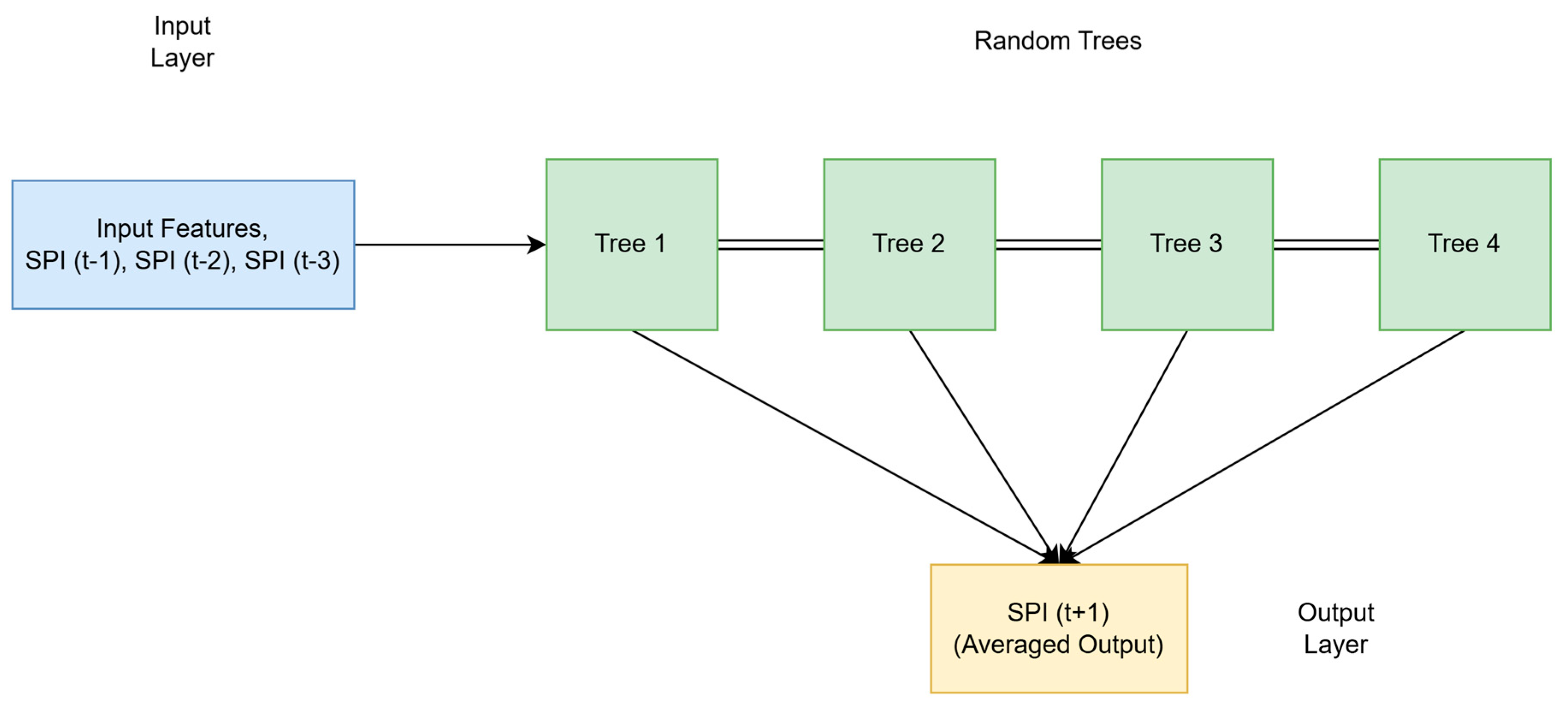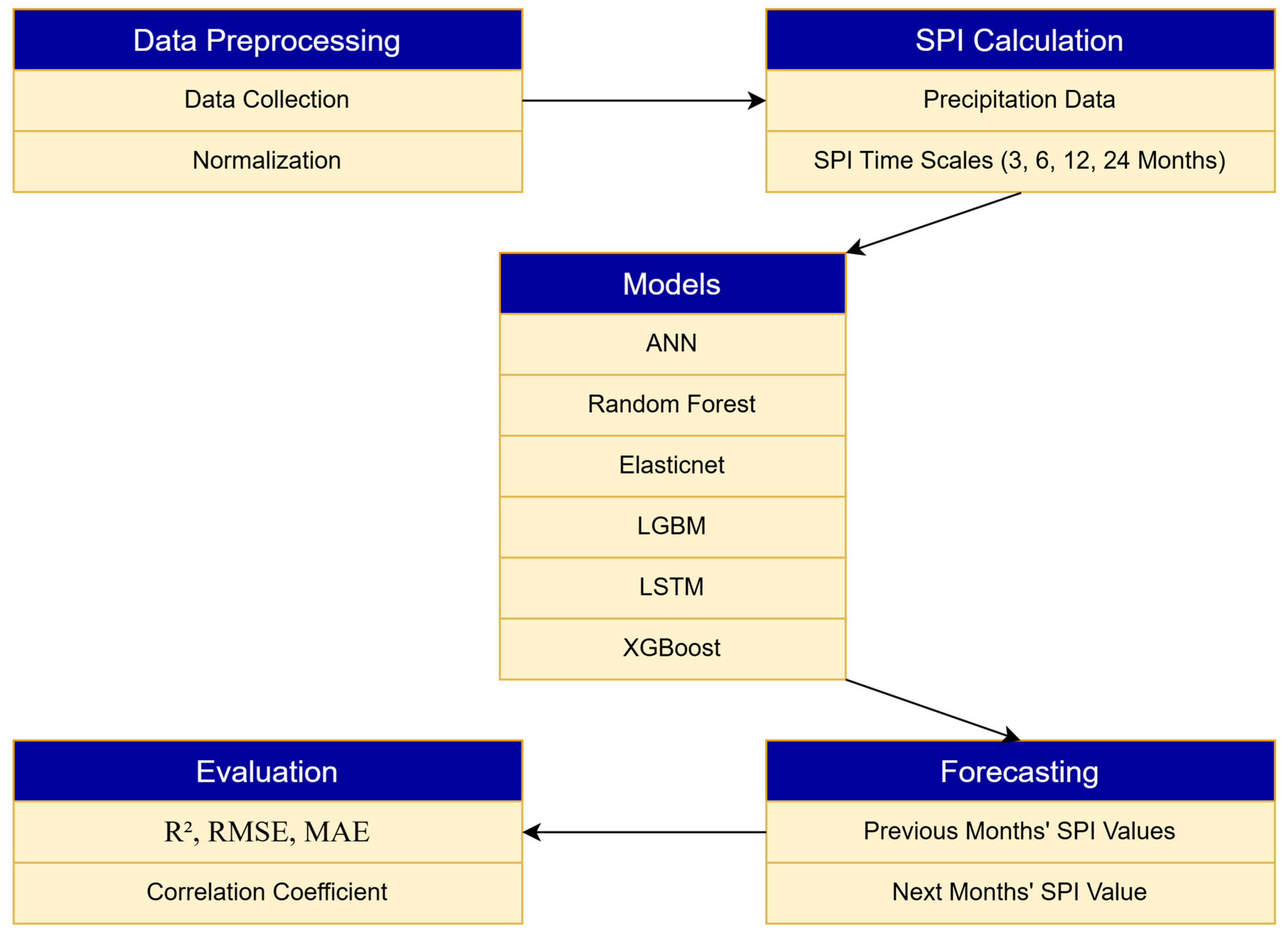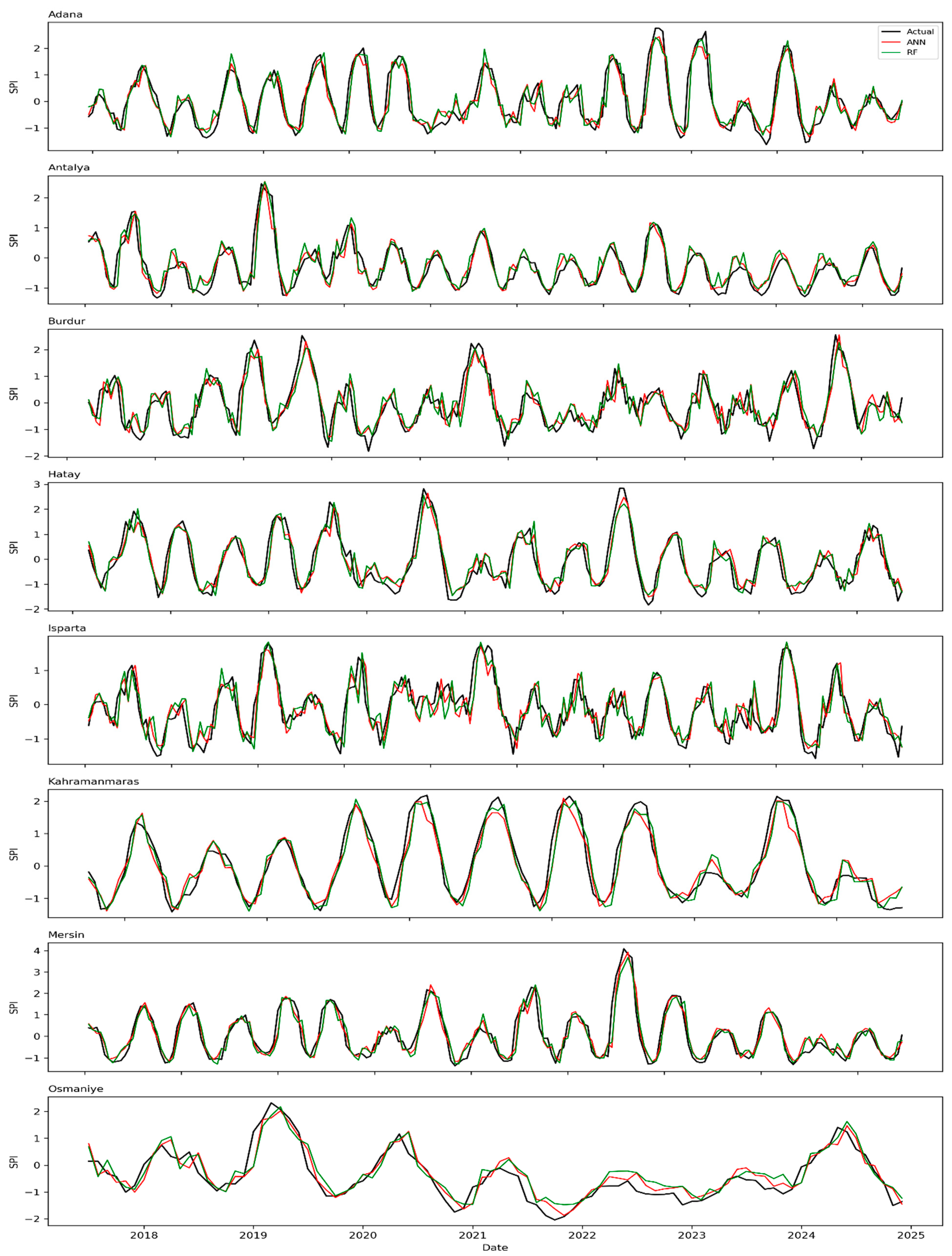Drought Forecasting Using Standard Precipitation Index and Artificial Intelligence Models in the Mediterranean Region of Türkiye
Abstract
1. Introduction
1.1. Related Studies
1.2. Main Contribution
- Century-Scale Dataset Utilization: First application of ANN and RF models using nearly 100 years (1929–2024) of continuous precipitation data across eight provinces in Türkiye’s Mediterranean Region.
- Comprehensive SPI Timescale Forecasting: Simultaneous drought prediction at four SPI accumulation levels (3, 6, 12, and 24 months), providing a multi-temporal understanding of short-, medium-, and long-term drought evolution.
- Comparative Model Benchmarking: Rigorous comparison of six AI models (ElasticNet, LGBM, XGBoost, LSTM, ANN, RF) using multiple statistical indicators (R2, RMSE, MAE, r), with ANN and RF identified as the most accurate and generalizable.
- Dual-Model Forecasting Framework: Demonstration of ANN–RF complementarity, where ANN captures deep temporal dependencies and RF ensures robustness against noisy short-term variations—forming a hybridizable prediction system.
- Region-Specific Drought Characterization: Identification of spatial and temporal drought behavior unique to the Mediterranean provinces, revealing coastal–inland variability and distinct hydrological responses.
- Operational Relevance: The study provides a practical, low-input drought forecasting framework that can be readily integrated into regional early-warning systems using only precipitation data.
- Scientific Contribution to AI–Hydrology Integration: The study advances understanding of how neural and ensemble learning algorithms can be tailored for hydroclimatic prediction under limited-data conditions, supporting future hybrid model development.
2. Material and Method
2.1. Study Area
2.2. Data
2.3. Standard Precipitation Index
2.4. Artificial Neural Networks
2.5. Random Forest
2.6. ElasticNet Regression
2.7. Light Gradient Boosting Machine (LightGBM)
2.8. Long Short-Term Memory (LSTM) Network
2.9. Extreme Gradient Boosting (XGBoost)
3. Results
3.1. Model Comparison and Selection
3.2. Model-Specific Interpretation
3.3. Model Selection Justification
3.4. Drought Prediction Performance of ANN and RF Models Across Multiple SPI Timescales
4. Discussion
5. Conclusions
Author Contributions
Funding
Data Availability Statement
Acknowledgments
Conflicts of Interest
References
- McKee, T.B.; Doesken, N.J.; Kleist, J. The relationship of drought frequency and duration to time scales. In Proceedings of the 8th Conference on Applied Climatology, Anaheim, CA, USA, 17–22 January 1993; Volume 17, pp. 179–183. [Google Scholar]
- Feng, Q.; Liu, W.; Si, J.; Su, Y.; Zhang, Y. Application of machine learning techniques to drought prediction using SPI. J. Hydrol. 2019, 576, 99–111. [Google Scholar] [CrossRef]
- Modarres, R.; da Silva, V.D.P. Rainfall trends in arid and semi-arid regions of Iran. J. Arid Environ. 2007, 70, 344–355. [Google Scholar] [CrossRef]
- Zhang, J.; Liu, D.; Zhang, Y.; Zhang, Y. Long short-term memory networks for SPI-based drought forecasting. Water 2020, 12, 144. [Google Scholar] [CrossRef]
- Dhanvijay, V.; Panhalkar, S.S. Deep Learning-Based Hydrological Drought Prediction in the Wardha River Basin, India. Nat. Hazards 2023, 117, 543–567. [Google Scholar]
- Aydin, M.; Demir, M.; Altun, Y. Comparison of LSTM and SVM methods through wavelet decomposition in drought forecasting. Environ. Model. Softw. 2023, 168, 105565. [Google Scholar]
- Wang, W.; Chau, K.W.; Cheng, C.T.; Qiu, L. A comparison of performance of several artificial intelligence methods for forecasting monthly discharge time series. J. Hydrol. 2021, 536, 165–176. [Google Scholar] [CrossRef]
- Belayneh, A.; Adamowski, J.; Khalil, B. Short-term SPI drought forecast using wavelet transforms and machine learning models. Hydrol. Earth Syst. Sci. 2014, 18, 4065–4078. [Google Scholar] [CrossRef]
- Mishra, A.K.; Singh, V.P. A review of drought concepts. J. Hydrol. 2010, 391, 202–216. [Google Scholar] [CrossRef]
- Karami, M.; Hezarkhani, A.; Beiranvand Pour, A. Drought prediction using advanced hybrid machine learning for arid and semi-arid environments. Sci. Total Environ. 2023, 873, 162361. [Google Scholar]
- Karaca, F. Derin Öğrenme Yöntemleri ile MODIS Tabanlı NDVI ve LST Zaman Serilerinin Kestirimi ve Kuraklık Şiddetinin Araştırılması. Ph.D. Thesis, İstanbul Teknik Üniversitesi, İstanbul, Türkiye, 2023. [Google Scholar]
- Türkmen, S. Yapay Zeka ve Uzaktan Algılama Tabanlı Kuraklık İzlemesi ve Tahmini: Trakya Bölgesi Örneği. Ph.D. Thesis, Namık Kemal Üniversitesi, Tekirdağ, Türkiye, 2023. [Google Scholar]
- Dile, Y.T.; Berndtsson, R.; Setegn, S.G. Hydrological response to climate change for Gilgel Abay River, in the Lake Tana Basin—Upper Blue Nile Basin of Ethiopia. PLoS ONE 2016, 11, e0163777. [Google Scholar] [CrossRef] [PubMed]
- Ahmad, M.; He, R.; Al-Amin, M.; Tahir, F. Forecasting drought using machine learning: A systematic literature review. Environ. Res. 2023, 232, 116200. [Google Scholar] [CrossRef]
- Reichstein, M.; Camps-Valls, G.; Stevens, B.; Jung, M.; Denzler, J.; Carvalhais, N.; Prabhat. Artificial intelligence and climate science. Nature 2019, 566, 29–39. [Google Scholar] [CrossRef]
- Ceyhunlu, A.I.; Ceribasi, G. Prediction of precipitation-temperature data and drought assessment of Türkiye with stochastic time series models. Pure Appl. Geophys. 2024, 181, 2913–2933. [Google Scholar] [CrossRef]
- Şimşek, O.; Ceyhunlu, A.I.; Ceribasi, G.; Keskiner, A.D. Evaluation of long-term meteorological drought in the Aras and Coruh Basins with Crossing Empirical Trend Analysis. Phys. Chem. Earth 2024, 135, 103611. [Google Scholar] [CrossRef]
- Ceyhunlu, A.I.; Ceribasi, G. Changes in precipitation and air temperature over Türkiye using innovative trend pivot analysis method. J. Water Clim. Chang. 2024, 15, 2446–2461. [Google Scholar] [CrossRef]
- Lalika, C.S.; Msigwa, M.K.; Li, L.; Komakech, H.C. Machine learning algorithms for the prediction of drought conditions in the Wami River sub-catchment, Tanzania. J. Hydrol. Reg. Stud. 2024, 53, 101794. [Google Scholar] [CrossRef]
- Elbeltagi, A.; Srivastava, A.; Ehsan, M.; Sharma, G.; Yu, J.; Khadke, L.; Gautam, V.K.; Awad, A.; Ding, J. Advanced stacked integration method for forecasting long-term drought severity: CNN with machine learning models. J. Hydrol. Reg. Stud. 2024, 53, 101759. [Google Scholar] [CrossRef]
- Ladouali, S.; Hamouda, N.; Djebbar, R.; Djebbar, Y. Short lead time Standard Precipitation Index forecasting using extreme learning machine and variational mode decomposition. J. Hydrol. Reg. Stud. 2024, 54, 101861. [Google Scholar] [CrossRef]
- Ma, C.; Yao, J.; Mo, Y.; Zhou, G.; Xu, Y.; He, X. Prediction of summer precipitation via machine learning with key climate variables: A case study in Xinjiang, China. J. Hydrol. Reg. Stud. 2024, 56, 101964. [Google Scholar] [CrossRef]
- Imane, L.; Lhoussaine, M.; Saida, B. Future groundwater drought analysis under data scarcity using MedCORDEX regional climatic models and machine learning: The case of the Haouz Aquifer. J. Hydrol. Reg. Stud. 2025, 58, 102249. [Google Scholar] [CrossRef]
- Dikshit, A.; Pradhan, B.; Alamri, A.M. Short-term spatio-temporal drought forecasting using Random Forests model at New South Wales, Australia. Appl. Sci. 2020, 10, 4254. [Google Scholar] [CrossRef]
- Belayneh, B.; Adamowski, J.F. Drought forecasting using new machine learning methods. J. Water Land Dev. 2013, 18, 3–12. [Google Scholar] [CrossRef]
- Haykin, S. Neural Networks and Learning Machines, 3rd ed.; Pearson Education: London, UK, 2009. [Google Scholar]
- Goodfellow, I.; Bengio, Y.; Courville, A. Deep Learning; MIT Press: Cambridge, MA, USA, 2016. [Google Scholar]
- Bishop, C.M. Neural Networks for Pattern Recognition; Oxford University Press: Oxford, UK, 1995. [Google Scholar]
- Zou, H.; Hastie, T. Regularization and variable selection via the Elastic Net. J. R. Stat. Soc. Ser. B 2005, 67, 301–320. [Google Scholar] [CrossRef]
- Ke, G.; Meng, Q.; Finley, T.; Wang, T.; Chen, W.; Ma, W.; Ye, Q.; Liu, T.-Y. LightGBM: A highly efficient gradient boosting decision tree. Adv. Neural Inf. Process. Syst. 2017, 30, 3146–3154. [Google Scholar]
- Hochreiter, S.; Schmidhuber, J. Long Short-Term memory. Neural Comput. 1997, 9, 1735–1780. [Google Scholar] [CrossRef]
- Chen, T.; Guestrin, C. XGBoost: A scalable tree boosting system. In Proceedings of the 22nd ACM SIGKDD International Conference on Knowledge Discovery and Data Mining, San Francisco, CA, USA, 13–17 August 2016; pp. 785–794. [Google Scholar]
- Coban, H.O.; Sorman, A.U.; Sensoy, A.; Sorman, A.A. drought indices and their performance for monitoring meteorological drought in Türkiye. Meteorol. Appl. 2019, 26, 292–305. [Google Scholar] [CrossRef]









| SPI Range | Category | Description | Typical Drought Condition |
|---|---|---|---|
| ≥2.00 | Extremely Wet | Exceptionally high precipitation | Flooding likely; saturated soils |
| 1.50–1.99 | Very Wet | Substantially above normal rainfall | Wet spell; high river and reservoir inflow |
| 1.00–1.49 | Moderately Wet | Slightly above average rainfall | Moist conditions; recovery from drought |
| −0.99–0.99 | Near Normal | Normal rainfall variability | No significant drought or wetness |
| −1.00–−1.49 | Moderately Dry | Noticeable rainfall deficit | Beginning of agricultural stress |
| −1.50–−1.99 | Severely Dry | Significant moisture deficit | Crop failure risk; reservoir drawdown |
| ≤−2.00 | Extremely Dry | Exceptional drought intensity | Major hydrological and socioeconomic impacts |
| Models | R2 | r | RMSE | MAE | |
|---|---|---|---|---|---|
| SPI-3 | ANN | 0.72 | 0.85 | 0.51 | 0.39 |
| RF | 0.68 | 0.83 | 0.55 | 0.42 | |
| ElasticNet | 0.46 | 0.69 | 0.75 | 0.58 | |
| LSTM | 0.37 | 0.62 | 0.80 | 0.63 | |
| LGBM | 0.36 | 0.61 | 0.81 | 0.64 | |
| XGBoost | 0.37 | 0.63 | 0.81 | 0.63 | |
| SPI-6 | ANN | 0.81 | 0.90 | 0.44 | 0.33 |
| RF | 0.77 | 0.88 | 0.48 | 0.36 | |
| ElasticNet | 0.71 | 0.85 | 0.55 | 0.41 | |
| LSTM | 0.62 | 0.80 | 0.63 | 0.49 | |
| LGBM | 0.57 | 0.78 | 0.68 | 0.52 | |
| XGBoost | 0.57 | 0.78 | 0.68 | 0.52 | |
| SPI1-2 | ANN | 0.84 | 0.92 | 0.42 | 0.29 |
| RF | 0.80 | 0.90 | 0.47 | 0.34 | |
| ElasticNet | 0.88 | 0.94 | 0.35 | 0.25 | |
| LSTM | 0.73 | 0.89 | 0.52 | 0.37 | |
| LGBM | 0.75 | 0.90 | 0.51 | 0.38 | |
| XGBoost | 0.67 | 0.87 | 0.57 | 0.41 | |
| SPI-24 | ANN | 0.81 | 0.85 | 0.29 | 0.20 |
| RF | 0.79 | 0.84 | 0.33 | 0.24 | |
| ElasticNet | 0.82 | 0.85 | 0.23 | 0.17 | |
| LSTM | 0.68 | 0.82 | 0.39 | 0.27 | |
| LGBM | 0.68 | 0.82 | 0.40 | 0.29 | |
| XGBoost | 0.63 | 0.80 | 0.43 | 0.31 | |
| Mean SPI | ANN | 0.79 | 0.88 | 0.41 | 0.30 |
| RF | 0.76 | 0.86 | 0.45 | 0.34 | |
| ElasticNet | 0.72 | 0.83 | 0.47 | 0.35 | |
| LSTM | 0.60 | 0.78 | 0.59 | 0.44 | |
| LGBM | 0.60 | 0.78 | 0.59 | 0.45 | |
| XGBoost | 0.56 | 0.77 | 0.62 | 0.47 |
| Study | Model | Region | Main Result |
|---|---|---|---|
| This Study—ANN (SPI-24) | ANN | Osmaniye (TR) | R2 = 0.940 |
| This Study—RF (SPI-24) | RF | Osmaniye (TR) | R2 = 0.894 |
| Zhang et al. [4] | LSTM | China | R2 = 0.920 |
| Karami et al. [10] | SVM-POA | Iran | R2 = 0.980 |
| Dhanvijay & Panhalkar [5] | LSTM | India | R2 = 0.920 |
| Aydin et al. [6] | LSTM-Wavelet | Türkiye | R2 = 0.994 |
| Belayneh et al. [8] | Wavelet + SVR | Ethiopia | R2 = 0.885 |
| Karaca [11] | CNN/ConvLSTM | Türkiye | R2 = 0.890 |
| Türkmen [12] | ConvLSTM/XGBoost | Türkiye | R2 = 0.910 |
| Lalika et al. [19] | LSTM | Tanzania (Wami Basin) | NSE/R ≈ 0.99 (SPI-6/9) |
| Elbeltagi et al. [20] | CNN-LSTM Hybrid | Upper Egypt | R2 = 0.885 (PDSI) |
| Ladouali et al. [21] | VMD-ELM | Algeria | Improved SPI forecasts (short lead times) |
| Ma et al. [22] | ANN | Xinjiang, China | Robust accuracy; key teleconnections (ENSO, AMO) |
| Imane et al. [23] | RF + SPI/SPEI | Haouz Aquifer, Morocco | RF best; severe droughts under RCP 8.5 |
Disclaimer/Publisher’s Note: The statements, opinions and data contained in all publications are solely those of the individual author(s) and contributor(s) and not of MDPI and/or the editor(s). MDPI and/or the editor(s) disclaim responsibility for any injury to people or property resulting from any ideas, methods, instructions or products referred to in the content. |
© 2025 by the authors. Licensee MDPI, Basel, Switzerland. This article is an open access article distributed under the terms and conditions of the Creative Commons Attribution (CC BY) license (https://creativecommons.org/licenses/by/4.0/).
Share and Cite
Ergüven, R.; Aydin, A.B.; Avci, D. Drought Forecasting Using Standard Precipitation Index and Artificial Intelligence Models in the Mediterranean Region of Türkiye. Appl. Sci. 2025, 15, 12172. https://doi.org/10.3390/app152212172
Ergüven R, Aydin AB, Avci D. Drought Forecasting Using Standard Precipitation Index and Artificial Intelligence Models in the Mediterranean Region of Türkiye. Applied Sciences. 2025; 15(22):12172. https://doi.org/10.3390/app152212172
Chicago/Turabian StyleErgüven, Rojhat, Alp Buğra Aydin, and Derya Avci. 2025. "Drought Forecasting Using Standard Precipitation Index and Artificial Intelligence Models in the Mediterranean Region of Türkiye" Applied Sciences 15, no. 22: 12172. https://doi.org/10.3390/app152212172
APA StyleErgüven, R., Aydin, A. B., & Avci, D. (2025). Drought Forecasting Using Standard Precipitation Index and Artificial Intelligence Models in the Mediterranean Region of Türkiye. Applied Sciences, 15(22), 12172. https://doi.org/10.3390/app152212172








